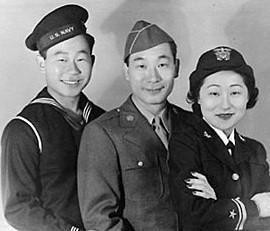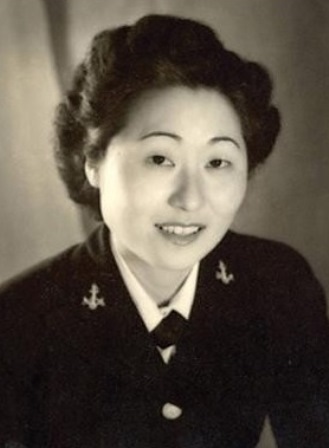CUDDY-SUSAN
SUSAN AHN CUDDY

LT

FIRST ASIAN-AMERICAN WOMAN IN THE NAVY
Susan Ahn was born in Los Angeles, California, on January 16, 1915 to Changho Ahn and Helen Ahn, the first married Korean couple to emigrate to the United States in 1902. Her father was a famous independence leader for Korea in the early 20th century who worked tirelessly to throw off the shackles of Japanese domination over his homeland. In furtherance of his work he made independent related trips to Korea and eventually he was arrested and died in 1937 under torture in Japanese custody. This inspired Susan Ahn to have a deep desire to fight against Japanese imperialism and when the U.S. declared war on Japan after Pearl Harbor, Susan and two of her brothers joined the U.S. military. Following graduation in 1940 from San Diego State College with a degree in Sociology, Susan initially requested to sign up for the Naval Reserve Midshipmen’s School, but her application was rejected because she was too “oriental.” She thus joined the Waves as an enlisted service member in December 1942. During her recruit training she was quickly recognized for her abilities, was selected as a candidate for officer school, and was soon commissioned as an Ensign, the first Asian-American woman in the Navy.
Her first assignment was as a Link Trainer instructor, teaching aviators how to maneuver in a simulator cockpit. This assignment was followed by duty as a gunnery officer teaching how to fire a .50-caliber machine gun. She later told a biographer, “A lot of people thought that women didn’t belong in the service. That made us try harder.” She also battled prejudice being an Asian-American. It is written that during gunnery instruction a pilot protested having to take directions about when to start shooting and said, “I’m not shooting until I see the whites of those Japs’ eyes.” Ignoring the slur and true to character, Susan took charge and replied, “I don’t care what you do up there. But when you’re down here with me, you do what I tell you to do.”
Susan Ahn’s next assignment was with Naval Intelligence. Initially she was again met with resistance as one of her supervisors refused to let her near classified materials, not trusting her due to her ethnicity. However, she overcame this and became a codebreaker, a work that would lead her later to the National Security Agency (NSA). She also served as a liaison from Naval Intelligence to the Library of Congress. While assigned to Naval Intelligence she became acquainted with Francis X. Cuddy. He was also a codebreaker and fluent in Japanese, and the two fell in love. To get married, they defied both of their families and the racist miscegenation laws of Virginia, where the two lived at the time. They were married in 1947 at a base chapel in Washington, DC, and she became Susan Ahn Cuddy.
Upon release from the Navy, Susan went to work for NSA where she reportedly led a team of over 300 linguists and other experts in the Russia section as a section chief, while also working on various top secret projects for the Department of Defense. This was at the height of the Cold War, before the Women’s Liberation Movement, before the Civil Rights Movement. Ahn even received a fellowship from the NSA in 1956 to study at the University of Southern California to further her career. Eventually the now Mrs. Cuddy left NSA to spend time with her growing family while her husband continued his Navy career where he served for 33-years.
The Cuddy’s eventually moved back to Los Angeles where Susan joined the family restaurant business. In her later years, she was a paragon of the Korean- American community, especially in Los Angeles. Two bouts of breast cancer did not slow her down as she continued to participate in community activities and even campaigned for candidate Barak Obama. In 2003, the State Assembly of California of District 28 named Susan Cuddy the Woman of the Year in honor of her commitment to public service. In 2006 she received the American Courage Award from the Asian American Justice Center in Washington, D.C. The Los Angeles County Board of Supervisors designated a “Susan Ahn Cuddy Day” and wrote, “These were all firsts as an Asian American woman in a man’s world…Anti-Asian sentiment was brazenly prevalent, but that didn’t deter Susan Ahn Cuddy – she just knew what her mission was.”
To the end she was a fighter and a pioneer in many things. She passed away at the age of 100 on June 24, 2015 and is buried at Forest Lawn Memorial Park in Los Angeles next to her husband who predeceased her in 1994.

RALPH, PHILIP, & SUSAN AHN
Submitted by CDR Roy A. Mosteller, USNR (Ret)

